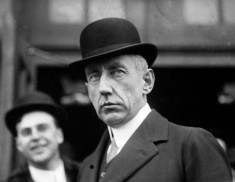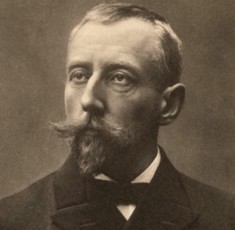| Roald Amundsen | |
|---|---|
 |
|
| Explorer | |
| Specialty | Antarctic expedition |
| Born | July 16, 1872 Borge, Østfold, Norway |
| Died | June 18, 1928 (at age 55) unknown |
| Nationality | Norwegian |
Roald Amundsen was a Norwegian explorer. He was best known for leading the first expedition to reach the South Pole in 1911. Amundsen was also active in the Arctic, leading an expedition to the North Pole in 1926. His other journeys included the first successful trip through the Northwest Passage beyond Canada. Amundsen, who had been interested in exploration from an early age, is presumed to have died in 1928, when he disappeared while attempting to rescue comrades in the Arctic.
Early Life
Amundsen was born on July 16, 1872, in the small town of Borge. His family had a tradition of seafaring behind it, with several of its male members being ship owners or sea captains. Growing to more than six feet in height by the time he reached adulthood, Amundsen habitually slept with the windows of his bedroom wide open.
He would do this even in the depths of winter, since he believed that it would be good practice for the life of exploration he badly wanted to lead as a man. In 1897, he first sighted Antarctica, which was still almost untouched by explorers, and the frozen continent retained a hold on his imagination for the rest of his life.
Amundsen Earns Recognition
In 1903, Amundsen won his first measure of renown as a seaman when he captained an expedition through the Northwest Passage in a fishing boat of just 70 feet in length. The journey was long and hard, and the vessel was frequently trapped in ice.
Because of the necessity to wait for this to thaw before proceeding, it was three years before the party finished their traverse. On his return to Norway, Amundsen heard news that the British explorer, Ernest Shackleton, was to lead an expedition to Antarctica with the object of attaining the South Pole. The Shackleton voyage was unsuccessful, and Amundsen devoted large amounts of time to studying what had gone wrong with a view to avoiding such problems himself.
Amundsen Explores the Antarctic
 Although widely commended for his planning and organizational abilities, Amundsen was said to be a rather taciturn and even a stern man. He selected crew members that he believed would be able to cope with the unique demands of a long polar journey, and by the late summer of 1910, he was ready to set off.
Although widely commended for his planning and organizational abilities, Amundsen was said to be a rather taciturn and even a stern man. He selected crew members that he believed would be able to cope with the unique demands of a long polar journey, and by the late summer of 1910, he was ready to set off.
When his expedition left port in August of that year, rumor had it that he was actually heading for the North Pole – but in fact, he had secretly ruled out that option after hearing that the U.S. explorer Robert Peary had claimed to have reached 90 degrees north in 1909. Not even Norwegian officials were told of Amundsen’s change of heart, since the explorer worried that he would be told to avoid rivalry with Britain for political and diplomatic reasons.
Amundsen did not even tell his crew the full truth about where they were going until his ship, the Fram, had reached the waters off Morocco. Meanwhile, he had been engaged in the selection of sled dogs to pull his equipment once the party reached land. Amundsen considered this a matter of the utmost importance to the extent that the success or failure of his entire enterprise might depend on their abilities.
His British rival, Robert Falcon Scott, instead relied heavily on Siberian ponies, a decision which was to prove fatally flawed. Amundsen’s party reached the Ross Ice Shelf in mid-October of 1911 and quickly set off toward the Pole, three weeks ahead of Scott.
Reaching the South Pole
Amundsen’s party had excellent traveling conditions, thanks to unusually good weather for most of their journey. By December 7, the Norwegians had surpassed the farthest point reached by the earlier Shackleton expedition, and a week later the South Pole itself was attained. Amundsen himself set up a Norwegian flag at the Pole before he and his party began the long return journey.
Thanks to their meticulous preparation, this leg too was relatively straightforward, and on January 25, 1925, they were safely back at base camp. The expedition had been traveling over land for around 1,800 miles over 99 days. Scott’s expedition reached the Pole in mid-January, but perished in appalling blizzards on the return leg, barely 10 miles from a supply depot.
Further Explorations and Death
Amundsen himself continued to undertake further adventures, most of them in the polar regions. Of these, his most notable expedition was a dirigible flight which passed directly over the North Pole in 1926. Because of doubts about whether Peary’s 1909 party had accurately reported their final position, Amundsen’s trip is now generally accepted as the first time that the North Pole was attained for certain.
Two years later, however, while on another journey, he disappeared. On June 18, 1918, he was attempting to rescue fellow explorers in the Arctic Ocean from the air, but his plane was lost at sea. Despite a three-month search, Amundsen’s body was never found.